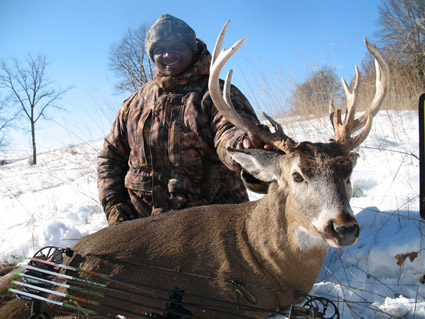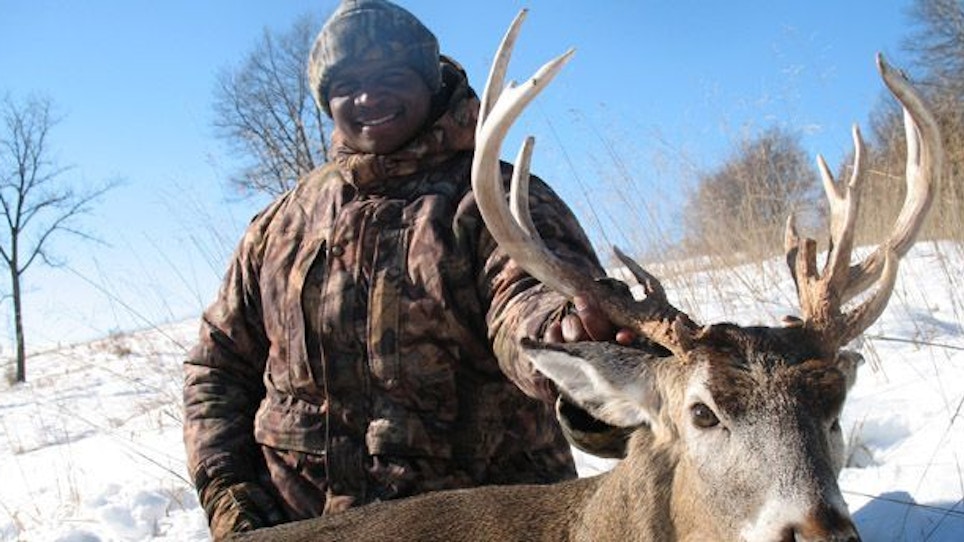Big-Woods Bucks
 Patterning deer to food sources in the big woods can be more of a challenge. Often they feed on browse, and if the snow’s not too deep, they will wander and feed almost everywhere.
Patterning deer to food sources in the big woods can be more of a challenge. Often they feed on browse, and if the snow’s not too deep, they will wander and feed almost everywhere.
In some places — and especially as snow deepens — bowhunting prospects improve. For several years running I hunted the northern Wisconsin late season and could count on filling my tag. The key? Cedar swamps in deep snow. Northern deer concentrate (“yard-up”) in protected areas of cedar and other rich browse, even though they soon create browse lines. I’m not sure exactly what the advantage is, other than deepening snow lets them reach another inch higher. My method was to climb trees and cut off a supply of branches. In no time the deer would find them and keep returning looking for more. I also bow-bagged a couple of deer by still-hunting through cedar swamps, where the method seems more workable than in most other situations.
Other good big-woods food concentrations include active logging operations. I’ve seen deer stand on the fringes waiting for the skid loaders to shut down for the day so they can come in and go to work on the freshly cut tree tops.
Corn Stalking
Have you ever seen how completely a bowhunter in snow camo can disappear on a white winter’s day? Are you frustrated by bucks that have “gone nocturnal” since the redcoat invasion? Have you been wishing for a way to detach your rear end from that deadly boring and bone-chilling tree stand, yet continue the hunt?
Then it’s time that you tried corn stalking. It can be one of the easiest and most exciting ways to fill that wrinkled old deer tag on expiration eve.
Stalking whitetails in standing corn is something that most of us have heard of but few of us practice. Many of us have tried it only to forsake the technique for one reason or another: Too difficult, too frustrating, too few deer sightings.
The problem I think is that a bowhunter just strikes off on a walk through the corn, not knowing what he faces, not realizing there are subtle tactics that make all the difference.
I was fortunate to have known the late, great Toad Smith, a fabled bowhunter from Iowa — a state where you adapt to corn or die. Toad had elevated corn hunting to a high art form, and once during some idle time on a faraway prairie-deer hunt, Toad explained to me his secrets of hunting corn.
At least three conditions must exist for corn stalking to work, he said, or you might as well be home watching the game.
First, it has to be late in the season and snowy. If the ground is brown, your chances of sneaking up on and shooting a deer in corn are about as good as lobbing an arrow into a cornfield and hoping it hits a deer in there somewhere.
The second requirement is a steady wind. No one can stalk through a field of dry corn quietly. You use the noise of rustling corn leaves to cover you.
The third requirement is the right equipment. It is very easy to become disoriented in a cornfield, so a compass is essential. You also need binoculars, sometimes for long-range glassing, but mostly for close inspection of a bedded deer you’ve discovered. Good camo is crucial, because you’ll be stalking within 10 yards of a deer that might be looking directly at you (I told you this was going to be exciting!). Use a very light-patterned camo or pure white. You’ll be trying to blend with white snow, off-white sky, and corn bleached to an almost white with a few somewhat darker features. Be sure you are covered with camo from head to toe, with special attention to face, hands and bow.
Toad said you need a simple stick bow for this kind of hunting, because the “stuff” on a compound might become too entangled in the thick corn, and because instinctive shooting is necessary to thread arrows through narrow passages. He also advised me to use carbon arrows, “because they recover immediately and get through openings other arrows won’t.” I think he was splitting hairs on this one, and I say use your regular bow and arrows.
Choose your cornfield carefully, however. There are good cornfields and bad; most are barren of deer. Good ones generally have some topography and are close to another kind of cover, such as woods or a swamp. The best fields have scattered grassy patches such as low, wet spots the farmer couldn’t plow. This is where the big bucks prefer to bed.
I like to find a field with fresh tracks going into it. Fresh as in it was snowing during the night, and at first light you find tracks with no snow in them going into a cornfield and not coming out.
Pick your best cornfield where the wind today is blowing across the rows, and start 50 yards from one corner on the downwind edge. Walk into the wind, peeking carefully into each row before you step into it. If you see no deer, proceed row by row to the opposite edge. Circle back in a way that won’t disturb the area you haven’t covered, and enter the rows again 100 yards or so down the field.
If you do see a deer, freeze. Don’t try to shoot down a row; a deer will detect you and bolt almost every time, and it never offers a good position for such a shot. Use your binocular to determine whether it’s a deer you want and which way it’s lying. You need to know this because you’re going to back up six rows and sneak into a position where you can shoot straight across the rows. At that point you won’t be able to see much of the deer, and knowing how he is lying helps ensure you are shooting at the right part of him.
Before backing up and stalking, range or carefully estimate how far down the row the deer lies. Then count your steps as you stalk, so you’ll know exactly where the deer is even if you can’t see it.
Pick your shot carefully, with careful consideration for the arrow’s actual path, because there will be plenty of obstructions. You might have to sneak closer, across the rows.
If you’ve done your job well, you’ll be enjoying corn-fed venison after all during those blustery winter days, with the warm feeling you’ve met and mastered one of the most exciting challenges in whitetail bowhunting.






